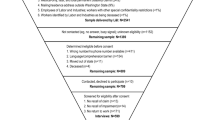Abstract
Existing national data may underreport the full burden of occupational injuries and illnesses. This study sought to provide more complete reporting and to assess disability that persisted following return to work. Workers (n = 205) with a musculoskeletal injury resulting in 5 or more days of lost time or restricted duty were recruited from three employers. Data on work status and functional limitations were derived from multiple sources including administrative records, medical records, and patient interviews at baseline and 6 months. Results indicate that many workers reported continuing difficulties functioning at work following return to full duty. Measures of health-related quality of life improved over 6 months, but bodily pain and physical functioning scores remained lower than expected based on national averages. Sixteen percent of workers were reinjured within a year following initial injury. Following return to work, many workers experienced reinjury or reported persistent limitations in function 6 months following injury. Based on study findings the conclusion is drawn that OSHA logs may provide accurate measures of initial episodes of time loss from work but may underrepresent the full magnitude of lost time following work injury.
Similar content being viewed by others
REFERENCES
Leigh JP, Markowitz SB, Fahs M, Shin C, Landrigan PJ. Occupational injury and illness in the United States: Estimates of costs, morbidity and mortality. Arch Intern Med 1997; 157: 1557-1568.
Bernard BP (ed.). Musculoskeletal disorders and workplace factors. Cincinnati: U.S. Department of Health and Human Services. Public Health Service. Centers for Disease Control and Prevention. National Institute of Occupational Safety and Health, 1997. DHHS (NIOSH) Pub. 97-141.
Webster BS, Snook SH. The cost of 1989 workers' compensation low back pain claims. Spine 1994; 19: 1111-1115.
Baldwin ML, Johnson WG, Butler RJ. The error of using returns-to-work to measure the outcomes of health care. Am J Ind Med 1996; 29: 632-641.
Dionne CE, Von Korff M, Koepsell TD, Deyo RA, Checkoway H. Acomparison of pain, functional limitations and work status indices as outcome measures in back pain research. Spine 1999; 24: 2339-2345.
Dasinger LK, Krause N, Deegan LJ, Brand RJ, Rudolph L. Duration of work disability after low back injury: A comparison of administrative and self-reported outcomes. Am J Ind Med 1999; 35: 619-631.
Kyes KB, Franklin G, Weaver MR. Reliability and validity of medical outcome and patient satisfaction measures among injured workers in Washington state: A pretest. Am J Ind Med 1997; 31: 427-434.
Ware JE, Kosinski M, Keller SD. SF-12: How to score the SF-12 physical and mental health summary scales. Boston:1998.
Ware JE, Jr., Sherbourne CD. The MOS 36-item short-form health survey (sf-36). Med Care 1992; 30: 473-481.
Hudak P, Amadio PC, Bombardier C. The Upper Extremity Collaborative Group. Development of an upper extremity outcome measure: The DASH (Disabilities of the Arm, Shoulder, and Hand). Am J Ind Med 1996; 29: 602-608.
Beaton DE, Cole DC, Manno M, Bombardier C, Hogg-Johnson S, Shannon HS. Describing the burden of upper-extremity musculoskeletal disorders in newspaper workers: What difference do case definitions make? J Occup Rehabil 2000; 10: 39-53.
Mustard C, Hertzman C. Relationship between health services outcomes and social and economic outcomes in workplace injury and disease: Data sources and methods. Am J Ind Med 2001; 40: 335-343.
Occupational Safety and Health Administration. U.S. Federal record, part 1904, 2001.
Fulton-Kehoe D, Franklin G, Weaver M, Cheadle A. Years of productivity lost among injured workers in Washington state: Modeling disability burden in workers' compensation. Am J Ind Med 2000; 37: 656-662.
Author information
Authors and Affiliations
Corresponding author
Rights and permissions
About this article
Cite this article
Evanoff, B., Abedin, S., Grayson, D. et al. Is Disability Underreported Following Work Injury?. J Occup Rehabil 12, 139–150 (2002). https://doi.org/10.1023/A:1016838510682
Issue Date:
DOI: https://doi.org/10.1023/A:1016838510682




